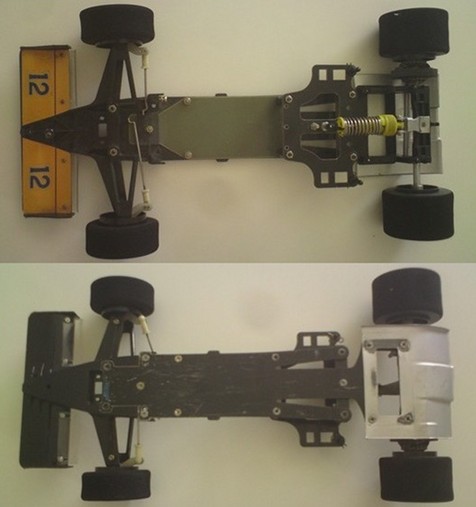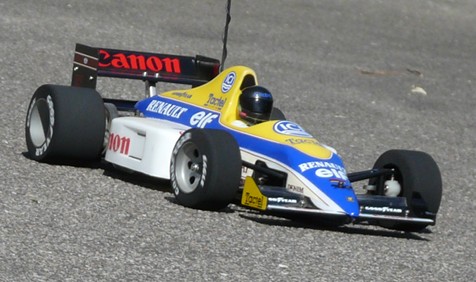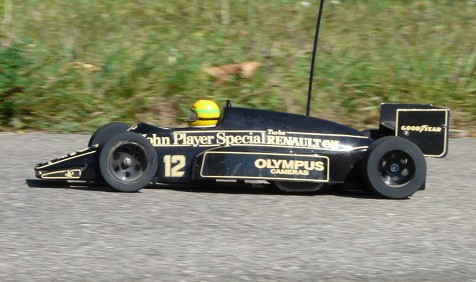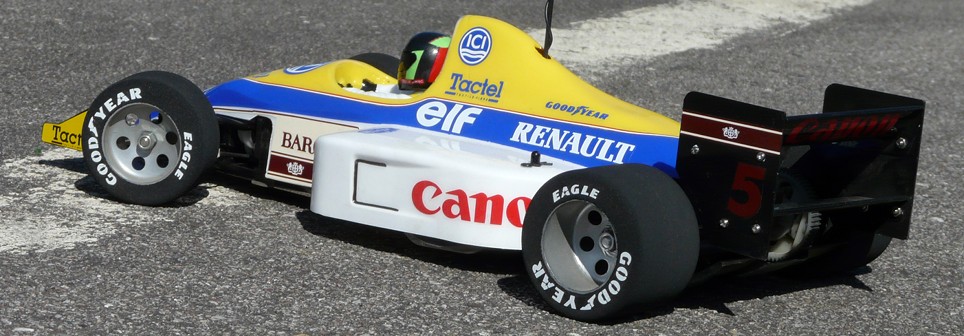Williams FW11B Honda F1 and Road Wizard F1 at the track
My friend David from RC 4 Old Nuts joined me at the track because I wanted to compare our thoughts about the Road Wizard and the Williams. So this review is the fusion of our respective conclusions when comparing both models.

Before to start, we immediately noticed the two chassis are diametrically opposed as far as stiffness and flexibility are concerned. On the front part (between the battery pack and the nose), the Road Wizard chassis is much more flexible than the Williams'. On the contrary, it is the exact opposite at the rear: the Williams' rear pod (or T) provides flexibility to the chassis when it makes the Road Wizard's stiffer. Let me recall the visual comparison between the two chassis, the Lotus Honda 99T shown here being the Williams' twin:
58053 Road Wizard F1 (1986)

58068 Lotus Honda 99T / 58069 Williams FW11B (1987)

Once the models ready to run on the track, another major difference can be observed:

From the photo, it looks like the Road Wizard's ride height is significantly lower than the Williams'. After some measuring, this is not an optical distortion due to the camera:
| Front nose | Middle chassis | Rear pod | |
| Road Wizard F1 | 5 mm | 4 mm | 4 mm |
| Williams FW11B Honda F1 | 7 mm | 7 mm | 7 mm |
One could naturally worry about the battery pack health when you see it so close from the asphalt on the Road Wizard. Don't worry: on this chassis, this is the front drivetrain that is flexible, the rear part being stiff enough not to spread electrons on the track.
Now, let's drive them. For this run, both chassis have the same setup: front wing plates set for the maximum downforce, dampers set to soft, same battery packs, same motors (Mabuchi 540), same motor pinion (17T) and same electronic speed controller (TEU-101BK). Only the receivers and the antenna tube are different.


We swapped transmitters several times in order to better compare our thoughts but the conclusion is the same for both drivers:
 Road Wizard F1
Road Wizard F1
The chassis tends to bounce at the front at high speed provoking instability that stresses the driver. Rather precise when entering corners, the rear drivetrain lacks grip and makes the car oversteer.
 Williams FW11B Honda F1
Williams FW11B Honda F1
The driver feels much more confident thanks to a better grip, but also thanks to the overall chassis stability. The overall handling is very similar to more modern F1s like the F102 chassis or the F104 at this level of motor power.
Above all, we need to talk about the sound made by the Road Wizard since it greatly influences the drivers' insecure feeling when driving it. The transmission is not guilty since it is the exact same on the Williams. In fact, the sounds are made by the chassis scratching on the track: due to its very low ground clearance, the Road Wizard scratches on any track default and the chassis underneath proves it happens very often. Moreover, we noticed the Road Wizard's spur gear sometimes hits the rear undercowl and makes an upsetting sound. This problem no longer exists on the Williams because of a slightly different rear undercowl shape.

The conclusions we made about these two models prove Tamiya quickly made improvements on their first modern Formula 1, especially by reversing the flex point of the chassis to the rear.
The Road Wizard is an important model because it started the modern Formula 1 era in Tamiya's range of products. In addition, the Williams FW11B reveals to be as important because the improvements Tamiya made defined the chassis handling basis of every Formula 1 they made ever since. I can even say the Williams' handling is so close to my Footwork FA13 that I would have a hard time describing real differences between them. My friend David from RC 4 Old Nuts also said differences with his modern F104 chassis are not obvious at this level of motor power. On the other hand, they would probably become more obvious as motor power increases.
Related articles:
- 58003 Tyrrell P34 Six Wheeler
- 58011 Ferrari 312T3
- 58014 Martini Mk.22 Renault
- 58053 Road Wizard F1
- 58084 Ferrari F189 Late Version - F101
- 58114 Footwork FA13 Mugen Honda - F102
- 58179 Williams Renault FW18 - F103RS
- 58288 Ferrari F2001 - F201




